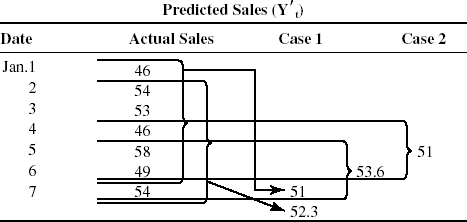15.2. Smoothing Techniques
Smoothing techniques are a higher form of naive models. The two typical forms are moving averages and exponential smoothing. Moving averages are the simpler of the two.
Moving Averages
Moving averages are averages that are updated as new information is received. With the moving average, a manager simply employs the most recent observations to calculate an average, which is used as the forecast for the next period.
Example 2
Assume that the marketing manager has these sales data:
| Date | Actual Sales (Yt) |
|---|---|
| Jan.1 | 46 |
| 2 | 54 |
| 3 | 53 |
| 4 | 46 |
| 5 | 58 |
| 6 | 49 |
| 7 | 54 |
In order to predict the sales for the seventh and eighth days of January, the manager has to pick the number of observations for averaging purposes. Let us consider two cases. One is a six-day moving average and the other is a three-day average.
Case 1

where Y' = predicted
Case 2

Predicted Sales (Y't)

In terms of weights given to observations, in Case 1, the old data received a weight of ⅚ and the current observation got a weight of ⅙. In Case 2, the old data received a weight of only ⅔ while the current observation received a weight of ⅓.
Thus, the marketing manager's choice of the number of periods to use in a moving average ...
Get Budgeting Basics and Beyond now with the O’Reilly learning platform.
O’Reilly members experience books, live events, courses curated by job role, and more from O’Reilly and nearly 200 top publishers.

